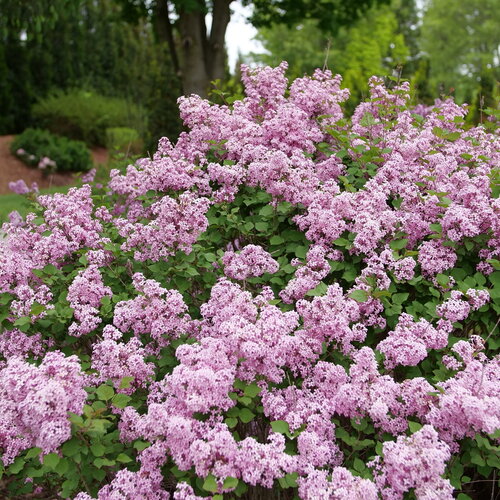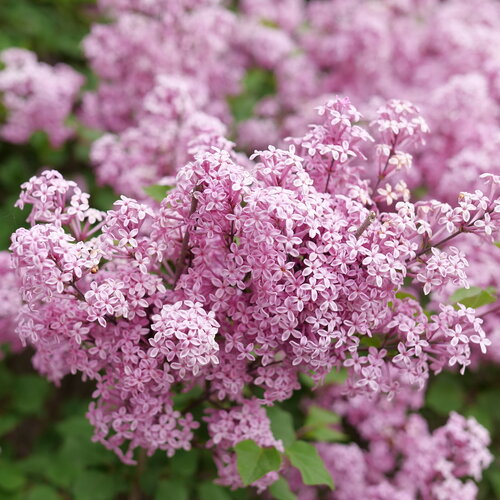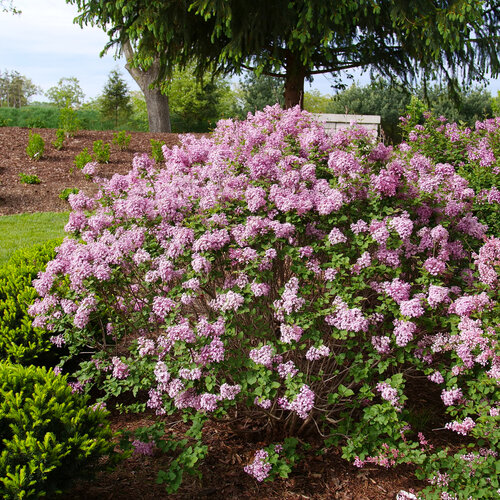I planted this last spring as a quart-sized shrub. It was very healthy and put on a reasonable amount of growth. It was safe from the rabbits all winter, but as the snow began to melt they unfortunately started to nibble. There were buds setting up so I don’t know if there will be any on the old wood this spring. Looking forward to more growth and maybe a few blooms later this fall.
Bloomerang Purpink® Reblooming Lilac Syringa x pubescens
- Sun
- Spring
- Summer
- Fall
-
36 - 60 Inches24 - 36 Inches24 - 36 Inches91cm - 1.5m61cm - 91cm61cm - 91cm
Features
Get ready to debate! Are the flowers on Bloomerang Purpink® a lovely shade purple or are they pale pink? We couldn’t decide, so we combined them in the name to let you decide. The real conversation starts when you see just how many blooms it puts out in the spring and again later on in the summer. It’s one of the most prolific rebloomers in our series, which is saying something! It belongs in a highly visible spot in your garden, like near a front door or by your driveway.
Why grow Bloomerang Purpink® lilac?- Unique coloring starts conversations and encourages multiple visits to the garden
- Incredible rebloom
- Reliable disease resistance
Fragrant FlowerContinuous Bloom or RebloomerDisease ResistantLong BloomingFall InterestAttracts:BeesButterfliesResists:DeerCharacteristics
Plant Type:ShrubShrub Type:DeciduousHeight Category:MediumGarden Height:36 - 60 Inches 91cm - 1.5mSpacing:24 - 36 Inches 61cm - 91cmSpread:24 - 36 Inches 61cm - 91cmFlower Colors:PurpleFlower Shade:LavenderFoliage Colors:GreenFoliage Shade:GreenHabit:MoundedContainer Role:ThrillerPlant Needs
Light Requirement:SunThe optimum amount of sun or shade each plant needs to thrive: Full Sun (6+ hours), Part Sun (4-6 hours), Full Shade (up to 4 hours).
Maintenance Category:ModerateBlooms On:New WoodBlooms On:Old WoodBloom Time:SummerBloom Time:SpringBloom Time:FallHardiness Zones:3a, 3b, 4a, 4b, 5a, 5b, 6a, 6b, 7a, 7bWater Category:AverageNeeds Good DrainageSoil PH Category:Alkaline SoilSoil PH Category:Neutral SoilUses:Border PlantUses:ContainerUses:Cut FlowerUses:LandscapeUses:Mass PlantingUses Notes:A classic addition to foundation plantings and mixed borders. Bloomerang lilac is also a popular choice for planting in decorative containers - learn more here.
Maintenance Notes:Plant only in full sun and well-drained soil; lilacs cannot tolerate soggy, wet conditions.
The rebloom of Bloomerang lilac occurs on the new growth the plant creates after its spring bloom. For the best rebloom, it's vital that the plant grows vigorously during late spring and early summer. Do this by keeping it well-watered and mulched and in plenty of sun (six hours a day at least). If you wish to fertilize it, you may do so in early spring, once the ground has thawed, and again in late spring, after it blooms.
If you want to prune Bloomerang lilac, do so immediately after its spring bloom. Never cut it back in fall, winter, or early spring - doing so will remove the spring flower buds. It is not necessary to prune Bloomerang lilac in order for it to rebloom. However, giving it a light trim after blooming does remove the developing seed heads (they look like green bananas, and some people don't care for the way they look on the plant), providing a neater look, and encourages more new growth for reblooming. Trimming after blooming will delay the rebloom by a few weeks compared to an untrimmed Bloomerang lilac.
Like nearly all lilacs, Bloomerang lilac actually requires a period of cold weather in order to bloom well. This is why lilacs are not typically suited to warmer climates. However, they are very, very cold tolerant and thrive in climates as cold as USDA zone 3.
Fun Facts:The botanical name of lilac, Syringa (suh-RIN-gah), is from the Greek word syrinx, which means tube. This is because the stems of lilac contain a spongy pith which can be remove, leaving a hollow tube that has traditionally been used to create pan-pipes.
Bloomerang Purpink® Syringa x pubescens 'SMNSPTP' USPP 35,123, Can PBRAF -
541321Browse reviews from people who have grown this plant.
-
Melissa Coons, Minnesota, United States, 39 weeks ago
-










